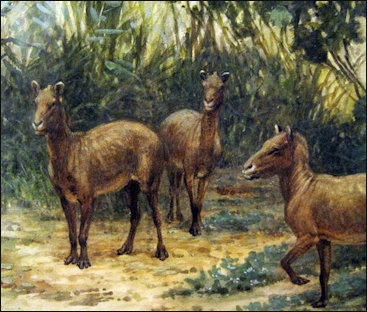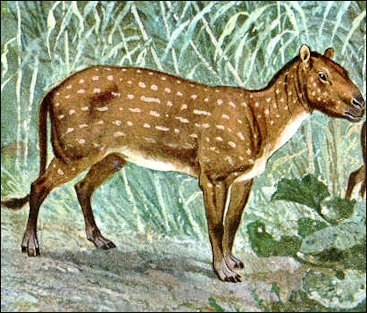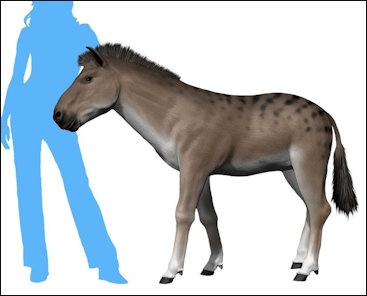HISTORY OF HORSES

Eohippus
Ancient horses originally evolved in the grasslands of the Great Plains of North America from rabbit-size dawn horses, called eohippus, which roamed the earth 65 million years ago. Distantly related to the rhino, early horses: 1) developed longer legs to help them escape predators such as giant dogs and saber toothed tigers; 2) were able to use bacteria and protozoa in their stomachs to help them digest grass without developing the complex stomachs of ruminants; and 3) develop an elongated central toe whose nail thickened into a hoof.
Jay F. Kirkpatrick and Patricia M. Fazio wrote in Natural History magazine, “Modern horses, zebras, and asses belong to the genus Equus, the only surviving genus in a once diverse family, the Equidae. Based on fossil records, the genus appears to have originated in North America about 4 million years ago and spread to Eurasia (presumably by crossing the Bering land bridge) 2 to 3 million years ago. Following that original emigration, there were additional westward migrations to Asia and return migrations back to North America, as well as several extinctions of Equus species in North America.[Source: Jay F. Kirkpatrick and Patricia M. Fazio, Natural History magazine, May 2008. Kirkpatrick earned a Ph.D. in reproductive physiology from the College of Veterinary Medicine at Cornell University and has studied fertility control for wild horses. Fazio, a research fellow at the Science and Conservation Center, earned her Ph.D. in environmental history from Texas A&M University. /]
“Animals that on paleontological grounds could be recognized as subspecies of the modern horse originated in North America between 1 million and 2 million years ago. When Linnaeus coined the species name, E. caballus, however, he only had the domesticated animal in mind. Its closest wild ancestor may have been the tarpan, often classified as E. ferus; there is no evidence, though, that the tarpan was a different species. In any case the domesticated horse probably did not arise at a single place and time, but was bred from several wild varieties by Eurasian herders.” /
As horses evolved they grew larger and larger and developed into a number of forms. They crossed the Bering Strait and spread throughout Asia and then Europe and Africa, roaming every continent but Australia and Antarctica. Ancient man hunted and painted images of them 25,000 years ago. These are believed to be the ancestors of domestic horses.
In America horses died out, mostly likely as the result of overhunting by early Americans. They were displaced by cattle and antelope, and remained absent until they were reintroduced by the Spanish in 1519. Wild horses are nearly extinct except for a few small herds in Central Asia.
Websites and Resources: Mongols and Horsemen of the Steppe "The Horse, the Wheel and Language, How Bronze-Age Riders from the Eurasian Steppes shaped the Modern World", David W Anthony, 2007 archive.org/details/horsewheelandlanguage ; The Scythians - Silk Road Foundation silkroadfoundation.org ; Scythians iranicaonline.org ; Encyclopaedia Britannica article on the Huns britannica.com ; Wikipedia article on Eurasian nomads Wikipedia Wikipedia article Wikipedia ; The Mongol Empire web.archive.org/web ; The Mongols in World History afe.easia.columbia.edu/mongols ; William of Rubruck's Account of the Mongols washington.edu/silkroad/texts ; Mongol invasion of Rus (pictures) web.archive.org/web ; Encyclopædia Britannica article britannica.com ; Mongol Archives historyonthenet.com
DNA and the Study of Prehistoric Horses

Hyracotherium eohippus
Jay F. Kirkpatrick and Patricia M. Fazio wrote in Natural History magazine, “In recent years, molecular biology has provided new tools for working out the relationships among species and subspecies of equids. For example, based on mutation rates for mitochondrial DNA (mtDNA) Ann Forstén, of the Zoological Institute at the University of Helsinki, has estimated that E. caballus originated approximately 1.7 million years ago in North America. More to the point is her analysis of E. lambei, the Yukon horse, which was the most recent Equus species in North America prior to the horse's disappearance from the continent. Her examination of E. lambei mtDNA (preserved in the Alaskan permafrost) has revealed that the species is genetically equivalent to E. caballus. That conclusion has been further supported by Michael Hofreiter, of the Department of Evolutionary Genetics at the Max Planck Institute in Leipzig, Germany, who has found that the variation fell within that of modern horses. [Source: Jay F. Kirkpatrick and Patricia M. Fazio, Natural History magazine, May 2008 /]
“These recent findings have an unexpected implication. It is well known that domesticated horses were introduced into North America beginning with the Spanish conquest, and that escaped horses subsequently spread throughout the American Great Plains. Customarily, such wild horses that survive today are designated "feral" and regarded as intrusive, exotic animals, unlike the native horses that died out at the end of the Pleistocene. But as E. caballus, they are not so alien after all. The fact that horses were domesticated before they were reintroduced matters little from a biological viewpoint. Indeed, domestication altered them little, as we can see by how quickly horses revert to ancient behavioral patterns in the wild. /
“Consider this parallel. To all intents and purposes, the Mongolian wild horse (E. przewalskii, or E. caballus przewalskii) disappeared from its habitat in Mongolia and northern China a hundred years ago. It survived only in zoos and reserves. That is not domestication in the classic sense, but it is captivity, with keepers providing food and veterinarians providing health care. Then surplus animals were released during the 1990s and now repopulate a portion of their native range in Mongolia and China. Are they a reintroduced native species or not? And how does their claim to endemism differ from that of E. caballus in North America, except for the length and degree of captivity? /
Perfectly Preserved 40,000-Year-Old Horse Found in Siberia
In 2018, an almost perfectly-preserved, 40,000-year-old baby horse was found in Siberia. Colin Drury of The Independent wrote: “The foal has been kept in such good condition by the region’s permafrost, it still has its hair, tail, mane and many of its internal organs, reports The Siberian Times.The discovery was made in the Yakutia region – long-known for fossils of woolly mammoths – by a joint expedition of scientists and archaeologists from Russia and Japan. [Source: Colin Drury, Independent Online, August 13, 2018 ]
“It is estimated the animal was just three months old when it died – although it has no visible wounds to suggest why. "This is the first find in the world find of a prehistoric horse of such a young age and with such an amazing level of preservation,” said Semyon Grigoryev, head of the Mammoth Museum in the city of Yakutsk and one of those on the expedition. “The extra value of the unique find is that we obtained samples of soil layers where it was preserved, which means we will be able to restore a picture of the foal’s environment. “We will report the exact time when it lived after studying the soil samples. The foal has completely preserved dark-brown hair, its tail and mane, as well as all internal organs. There are no visible wounds on its body.”
“The find, in a vast crater known as the Batagai depression, was located by scientists from the North-Eastern Federal University in Yakutsk and Kindai University in Osaka, Japan. It followed a similar unearthing in the same area nine years ago when locals in Batagai village found a bison calf and part of an ancient horse’s body.”
Horses in North America

merychippus, a horse that lived in North America
Horses originated in North America. The last prehistoric North American horses died out between 13,000 and 11,000 years ago, at the end of the Pleistocene, but by then horses had spread to Asia, Europe, and Africa.
The last North American horses were perhaps killed by early human hunters. Some horses made their way to Asia before the land/ice bridge over between present-day Bering Strait between Alaska and the Russian Far East. In Asia and Europe they were domesticated by humans, who later reintroduced horses to the Americas. In recent times, some horses escaped from large American horse-raising ranches. The offspring of those that survived and thrived in wild are today known as "wild" mustangs.
Jay F. Kirkpatrick and Patricia M. Fazio wrote in Natural History magazine, ““The wild horse in the United States is generally labeled non-native by most federal and state agencies dealing with wildlife management, whose legal mandate is usually to protect native wildlife and prevent non-native species from having ecologically harmful effects. But the two key elements for defining an animal as a native species are where it originated and whether or not it coevolved with its habitat. E. caballus can lay claim to doing both in North America. So a good argument can be made that it, too, should enjoy protection as a form of native wildlife.” [Source: Jay F. Kirkpatrick and Patricia M. Fazio, Natural History magazine, May 2008 /]
Early Man and Horses
Sandra L. Olsen wrote in Natural History magazine, “Before humans forged partnerships with horses, the interactions were those of predator versus prey. Ice Age hunters in Europe, Asia, and North America tracked and even drove horses, dispatched them with spears, and butchered them for food. In France and Spain, lively images of the forebears of our domesticated horse adorn the cave sanctuaries of early hunters, dating from late Ice Age times, some 12,000 to 30,000 years ago. The European depictions, which reveal that horses were greatly sought-after prey, also show that the ancient wild horse had a dun coat, erect mane, and stripes on the withers and legs. In those features, as well as in its stocky conformation and broad, massive head, it closely resembled the Przewalski’s horse (“Equus przewalskii”), a relative that nearly became extinct but which has been restored in limited numbers to Asiatic preserves. But based on evidence from chromosomes and mitochondrial DNA, the Przewalski has been ruled out as the ancestor of the domestic horse, so by a process of elimination, the most like candidate was the tarpan. [Source: Sandra L. Olsen, Natural History magazine, May 2008 ]

horses in Chauvet's cave
“The tarpan, unfortunately, “is” extinct. As the Ice Age drew to a close and global warming shifted ecological zones all over the world, the animal’s natural habitats—the large expanses of cold, dry steppe—began to contract and be replaced, often by deciduous forests. As the vegetation changed, so did the species of large herbivores living in a region. Cold-adapted animals shifted northward as far as possible, but eventually the largest of them all, the mammoth, went extinct. Reindeer persisted in the higher latitudes, but horse populations dwindled significantly, reduced to small enclaves sprinkled across the continent. Only on the Eurasian steppe from the Carpathian Mountains of Hungary across to Kazakhstan, and in a small part of northern Europe, did the tarpan survive. By about 9,000 years ago, it seems to have vanished from France, England, Spain, Italy, and the Near East; when the horse begins to be reintroduced into those regions 4,000 years later, it is most likely as domesticated livestock. The last tarpan finally died in Ukraine in the winter of 1918–1919.”
Humans Might Have Wiped Out Wild Horses in North America
Bjorn Carey wrote in Livescience, “Already charged with eradicating mammoths, the first North Americans might also have wiped out wild horses in Alaska, a new study suggests. The end of the Pleistocene era, around 12,000 years ago, was coupled with a global cooling event and the extinction of many large mammals, particularly in North America. This was also when humans first made their way into Alaska from Asia, leading some researchers to believe that extensive over-hunting helped drive the extinction of the massive beasts. Mammoths, for example, were a prime target of early hunters and were driven to extinction within roughly 500 years of humans' arrival on the continent. But another possibility is that a fast-spreading infectious disease brought down these and other animals.[Source: Bjorn Carey, Livescience, May 1, 2006 \=]
“Since the most recent truly wild horse fossil dates to about 12,500 years ago, scientists had thought these animals died out before humans were a factor. In the new study, researchers reevaluated some of the unreliable data used in previous calculations and determined that when gaps in the fossil record and radiocarbon dating errors are factored in, it is possible that humans and horses coexisted. \=\
"The fossil record's very incomplete, and just because the most recent remain is from 12,500 years ago, that doesn't mean that the horse became extinct at this time," said study co-author Andrew Solow of Woods Hole Oceanographic Institute. Radiocarbon dating techniques—the most common method of determining the age of organic material—can be off by 200 to 300 years, a significant error when considering a thousand-year window. As a result, it is impossible to rule out human hunting as the cause, or major contributing factor, to horse extinction in North America, Solow told LiveScience. The study is detailed in online edition of the journal the Proceedings of the National Academy of Sciences.” \=\
Przewalski's Horse
The Przewalski's horse is the only kind of truly wild horse left in the wild. A few can still be found in Mongolia. The tarpan horse of Europe and northern Asia went extinct in the mid 19th century. The "wild horses" in North America are descended of domesticated horses that had been released in the wild. The Przewalski's horse, also known as the wild Asiatic horse or takhi, isthe last remaining species of wild horse. It is found almost exclusively in zoos although some have been reintroduced to Mongolia. [Source: Natural History, July 2002]

Horse evolution
Przewalski's horses are small and stocky and look somewhat like mules. The closest living relative of the domestic horse, they are 2.2 to 2.6 meters in length, with a 80- to 110-centimeter-long tail, and weigh 200 to 300 kilograms. They are rusty brown to beige in color, with dark brown lower legs. Although they have different numbers of chromosomes they are the only members of the equid family capable of producing fertile offspring if interbred with domesticated horses.
Przewalski's horses are markedly different from domestic horses and regarded as a different species. They have several characteristics that are closer to the prehistoric ancestors of horses than to domesticated horses. They have a short neck, short back, stubby legs and a thin tail base and have a short mane and forelock. During the summer zebra-like stripes appear on their legs.
Przewalski's horses used roam the steppes and deserts of Mongolia, northern China, Kyrgyzstan and Uzbekistan. They were depicted in wall paintings but were considered too wild to domesticate and were pursued only for food. Another kind of horse was selected for domestication.
See Separate Article PRZEWALSKI'S HORSE factsanddetails.com
Image Sources: Wikimedia Commons
Text Sources: New York Times, Washington Post, Los Angeles Times, Times of London, Lonely Planet Guides, Library of Congress, U.S. government, Compton’s Encyclopedia, The Guardian, National Geographic, Smithsonian magazine, The New Yorker, Time, Newsweek, Reuters, AP, AFP, Wall Street Journal, The Atlantic Monthly, The Economist, Foreign Policy, Wikipedia, BBC, CNN, and various books, websites and other publications.
Last updated February 2019
